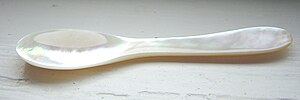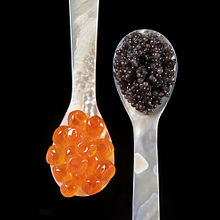


Caviar spoons are traditionally made of inert materials, such as animal horn, gold, mother of pearl, and wood. They range in length from 7 to 13 cm (2.7 to 5 in), and have a small shallow bowl that may be either oval or paddle shaped and a flat handle.
There is a custom that caviar should not be served with a metal spoon, because metal may impart an undesirable flavour. Though caviar is stored and sold in metal tins, non-reactive interior linings are put in place to prevent any adverse effects. Silver spoons are reactive, however, and thus may affect the flavor.
A caviar knife is frequently sold together with the spoon. It is a 5 inches long flat knife with a bulbous tip, typically also made of a fancy material like mother-of-pearl.
See also
References
- Wolke, Robert L. (2002). What Einstein Told His Cook: Kitchen Science Explained (1st ed.). New York: W.W. Norton. p. 163. ISBN 0393011836.
- "History of Cutlery: History of the Spoon". Eating Utensils. Retrieved 25 April 2014.
- Ettlinger 1992a.
- Tesauro, Jason and Phineas Mollod (2002). The Modern Gentleman (2nd ed.). : Ten Speed Press. p. 48. ISBN 9781607740063.
- Chandra, Gowri. "5 Myths About Eating Caviar and How to Unlearn Them". foodandwine.com. Retrieved 7 March 2020.
- Burnside, Margaret Word (Jan–Feb 2010). "Ask Margaret: Why can't caviar be served with metal spoons?". Tampa Bay Magazine. 25 (1). Retrieved 14 November 2012.
- Ettlinger 1992b.
Sources
- Ettlinger, Steve (1992a). "Caviar Spoon". The Kitchenware Book. McMillan Publishing Company. pp. 375–376. ISBN 0-02-536302-6. OCLC 1256259403.
- Ettlinger, Steve (1992b). "Caviar Knife". The Kitchenware Book. McMillan Publishing Company. p. 375. ISBN 0-02-536302-6. OCLC 1256259403.
This article about kitchenware or a tool used in preparation or serving of food is a stub. You can help Misplaced Pages by expanding it. |